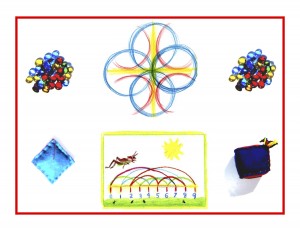Day 92
For one year, 365 days, this blog will address the Common Core Standards from the perspective of creating an alternate, ambient learning environment for math. Ambient is defined as “existing or present on all sides, an all-encompassing atmosphere.” And ambient music is defined as: “Quiet and relaxing with melodies that repeat many times.”
Why ambient? A math teaching style that’s whole and all encompassing, with themes that repeat many times through the years, is most likely to be effective and successful. Today’s post will focus on the second pair of standards which will be listed in blue, followed by their ambient counterparts.
The Standards for Mathematic Practice, Grade 1
#2 and #3: Reasoning and explaining.
2. Reason abstractly and quantitatively.
A 6-7 year old does not yet have the capacity to reason, much less abstractly. If the ego is not yet developed, there is no solid wall to bounce ideas off of. Steiner’s philosophy of child development, which runs parallel to Piaget’s, says that the ability to reason begins at age 7, begins being the operative word. Readiness is all. When a ripeness to learn is there, learning will occur with relative ease. A young child can be drilled and coached so abstract concepts are parroted back, and all of this can be effectively remembered as well, but much is lost in the process, and more to the point the subject taught in this way will engender resentment and dislike, often for life. This does not mean that math cannot be taught at this age, to the contrary, a lively love of the subject that can carry it lifelong can be implanted. And even the so-called abstract concepts can be presented successfully if safely ensconced in story and pictures. Make the abstract concrete and you will not only be able to teach abstraction and quantity, but you will teach it more effectively than you can imagine possible!
3. Construct viable arguments and critique the reasoning of others.
Again, the ability to argue or prove a point is not yet available to the 6-7 year old. If the foundation is well-built, argument and proofs will come along in due time. Both Piaget and Steiner posit that abstract reasoning cannot be expected until age 11 or 12. I’ve watched Common Core videos in which the teacher guided groups of students to exchange ideas and explain how they arrived at their answers. Often, individuals are told that though they’ve arrived at the right answer, they need to collaborate with others in their group to fulfill the (Common Core) requirement. At this age, there is a strongly compelling desire or need to please the teacher or parent. So the groups may go through the motions of collaboration, but it will be against the grain of healthy development. First graders are ready and willing to be disciples in the true sense of the word. Ready and willing to learn, but in a safe, protected environment the teacher constructs and conducts with discipline. Waiting for readiness is wise, and no time is lost rather healthy growth and wisdom are gained!
For four days, each of the four pairs of Mathematical Practice Standards will be examined with an eye toward what works as developmentally appropriate math in Grade 1, continuing with standards 4 & 5. Knowledge ensues in an environment dedicated to imaginative, creative knowing, where student and teacher alike surrender to the ensuing of that knowledge as a worthy goal.












